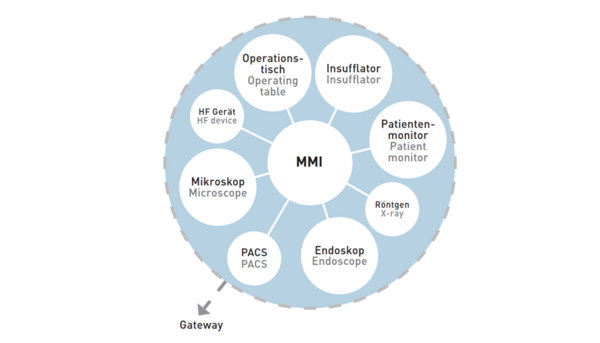
The integrated operating theatre
Using medical equipment in the OR of the future
A growing number of devices with increasingly complex functions; imaging techniques during surgery; utilisation of assistance and navigation systems: these are just some of the current trends in the field of medical equipment. They enable surgery to be performed minimally-invasively and with a higher level of precision. And yet, operating these devices requires ever-increasing attentiveness from the surgeon - and intuitive operability is a goal which is seemingly more and more difficult to realise.
The goal: interoperability
The manufacturers of medical equipment are therefore busy working on new generations of user interfaces. The goal behind development: one system to control several devices. In other words: the medical devices are integrated and the man-machine interface becomes interoperable. This not only improves ergonomic comfort and simplifies operation; it also increases clarity in the OR and raises hygiene levels – especially when the controls communicate with the medical devices by radio.
Moving towards dynamic integration
The dynamic integration of medical equipment - or, at the user level, the interoperability of user interfaces – is one of the development goals of the initiative OR.NET e.V., to which steute Meditec is committed as an associated partner. This integration will take place in three steps:
- The existing conventional medical equipment cannot only be operated at the device itself but also by transmission of their user interfaces.
- Different user interfaces are available for the operation of different medical equipment.
- Medical equipment can be connected to user interfaces via »plug & play« and vice versa.

Network visualisation
All options on one screen
A single interface for several medical devices and peripheral systems, e.g. lighting: this vision is now reality. A clear overview is provided by a screen which shows the surgeon, amongst other things, the current configuration for individual control elements. On the screen the physician can also call up data and medical images related to the patient from the hospital archive. The surgeon uses the screen to select the medical device he would like to activate next via the user interface. Combinations of several medical devices are also possible. In addition, he can select the configuration of the various control functions and thus adapt the user interface to his own personal preferences, as well as to the requirements of work processes and ergonomic comfort.
The number of interoperable medical devices which can be controlled via this central user interface is unlimited. The data can also be be made available at other workstations within the network. All connected medical devices and user interfaces communicate via the joint IT platform developed within the OR.NET e.V. project. The screen image presented here shows a project developed by the Chair of Medical Engineering at the RWTH Aachen, in collaboration with Beger Design, as part of OR.NET e.V. The user interface comprises foot control components from steute Meditec: medical devices are operated using three pedals and three push buttons.

First projects have been realised
For the dynamic integration of medical equipment, steute Meditec sees the next logical step in the development of innovative user interfaces. Our controls are already able to trigger different functions in one medical device, depending on the menu selected.
And now this multifunctionality is being extended to several devices. One example of an OR.NET e.V. project: a manufacturer of ultrasound dissectors and a manufacturer of surgical microscopes have agreed to communication standards enabling them to share the same steute Meditec foot control. The surgical microscope foot control, which permits up to 14 functions to be performed, can be switched over to actuate the dissector instead. steute Meditec estimates that in the coming years dynamic integration in the OR will become reality. We see it as our task not only to accompany these developments, but also to play an active role in guiding them - as a specialist for customised user interfaces for high-end medical equipment.













